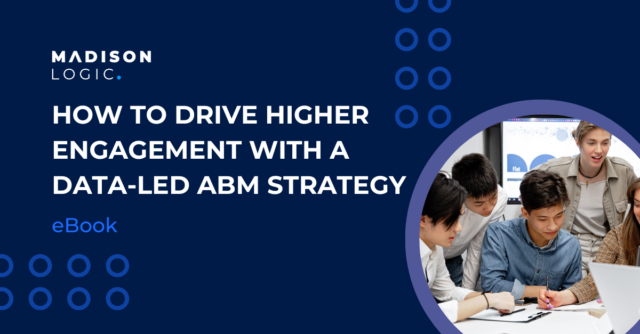
Anticipating future B2B marketing trends is crucial to campaign and strategy development. At a time marked by rapid technological advancements, unpredictable economic conditions, and continuously shifting consumer behaviors, staying ahead with the latest marketing trends is paramount to flexible marketing motions.
Yet the marketing landscape is also full of noisy predictions that, if you act on only because they’re the “next big thing in marketing” and don’t do your research, will impact your bottom line and make your motions more reactive than proactive.
Let’s stop that habit now. These are the five B2B marketing predictions that cut through the noise and set you up to deliver clear, insightful messaging to your audience. And be sure to download our comprehensive 2024 B2B Marketing Predictions eBook for a deeper dive into these predictions and advice on crafting practical strategies to capitalize on them.
1. Smarter Use Cases for Generative Artificial Intelligence (AI) and Machine Learning
It’s no surprise that AI and machine learning are the big talking points for B2B marketing predictions. Often considered the greatest technological advancement since the Internet, AI and machine learning offer a range of benefits that help businesses with tight budgets create efficient marketing campaigns while streamlining more time-intensive tasks, such as content ideation and audience research.
One of the most exciting applications of AI in B2B marketing is the use of generative AI to create unique, compelling content. Use generative AI to write blog articles, social media posts, and email campaigns. Some generative AI platforms even offer the opportunity to upload your brand guidelines to match your brand’s voice and tone to the copy it creates, which saves you time as you can focus on editing and checking the content for accuracy (versus drafting everything from scratch).
Marketers have been increasingly experimenting with machine learning to improve the effectiveness of their B2B marketing campaigns. By analyzing data from past campaigns, machine learning algorithms can identify trends and patterns that you can further study to optimize future campaigns. By saving time through the machine gathering the data and insights, you can focus on reaching the right customers with the right message at the right time.
In addition to these specific use cases, AI and machine learning automate a variety of marketing tasks, such as data entry, social media management, and customer service. Automation, whether analyzing customer feedback from various sources, working through competitive research, or simply publishing a social media post on multiple platforms at a specific time, offers further time-savings as it frees up time from more tedious tasks so you can focus on more strategic tasks that drive business growth.
Of course, there are also some challenges associated with the use of AI and machine learning in B2B marketing. One challenge is budgetary—these technologies can be expensive to implement. Another challenge is the learning curve with any new platform. Users must learn how to use the systems while also teaching them about brand voice, style guidelines, and any other aspects and expectations to prioritize in terms of generative writing and analysis capabilities. And finally, there’s the human element. Forrester predicts that over 70% of buyers will complain about the collateral vendors share due to growing frustration over poor personalization and failure to demonstrate an understanding their business needs. Whether it’s leveraging generative AI for content creation or using machine learning to improve the effectiveness of their B2B marketing campaigns, users cannot overlook the need for human interaction to achieve the desired result from the technology more effectively.
Forrester Research warns that rushing into generative AI presents significant risk. Multiple sources, including Forrester, cite complications with AI creating answers alongside general “nonsense” that you will need to work through to make readily accessible. Forrester also notes that 73% of its ConsumerVoices Market Research Online community will use Google to verify suspect responses from ChatGPT and other AI systems. Still, Forrester notes that four out of five decision-makers anticipate that implementing generative AI over the next 12 months will highly impact their businesses within two years.
2. More Focus on the Momentum from Brand Awareness to Demand Generation
Marketing teams have often had to tradeoff between their brand and demand activities. In 2024, however, there needs to be a greater emphasis on linking brand and demand activities, using brand awareness as a springboard for demand generation efforts to urgently drive leads down the funnel.
There are a number of reasons why this shift is happening:
- The B2B buying process has become increasingly complex and longer, with Forrester research finding that 67% of B2B marketers noticed buyers are taking longer to commit to purchases than last year. Marketers must now build multiple nurture paths for members of a company’s buying committee—which can include upwards of 14 people. These buying committee members have different concerns, and are now more likely to research products and services independently before making a purchase decision.
- The competition for B2B customers is becoming increasingly fierce. To stand out from the crowd, B2B marketers need to be able to demonstrate the value of their products and services.
- The rise of social media and other digital marketing channels has made it easier for B2B marketers to reach and engage with potential customers. This has created an opportunity for B2B marketers to build relationships with potential customers across multiple channels and nurture them into leads.
By focusing on the momentum from brand awareness to demand generation, B2B marketers can create more effective and efficient marketing campaigns that will help them reach their target audience and grow their business. But top–of–funnel activities tend to cost more. While you may need to provide education around effective brand-to-demand strategy alignment and measurement to get executive buy-in, you can begin by investigating your data.
Leaning into your intent data, firmographic data, technographic data, and buyer personas allows you to create consistent messaging throughout your brand and demand efforts. You can then build out a content roadmap that matches content to its ideal channel to remain top of mind and propel engagement from the buying committee.
3. Striking the Right Balance between Personalization and Customer Privacy
Marketers’ reliance on data for more relevant marketing collateral is rising—and so is buyers’ awareness in how companies use personal data to target them. With longer buying cycles, buyers expect relevant customer experiences from brands. To that end, however, there’s an expectation that companies will also keep their information safe.
B2B marketers need to find a way to strike the right balance between personalization and customer privacy. There are many ways to do this:
Be transparent about how you collect and use customer data
Customers are more likely to be comfortable sharing their data if they know exactly how it will be used. Make sure to have a clear and concise privacy policy that explains what data you collect, how you use it, and who you share it with. Google stated that they were phasing out third-party cookies in 2024, but have since changed their approach. You should still prepare for the transition to an emphasis on cookieless marketing by building solid first-party data collection strategies and partnerships with transparent third-party data providers.
Partner with orgs that implement strong data security measures
Customers need to know that their data is safe with you. Make sure to have robust security measures in place to protect customer data from unauthorized access, use, or disclosure. That includes identifying and partnering with organizations that adhere to national and international privacy regulations, guidelines, and best practices.
Provide customers with easy ways to opt out of data collection and use
Customers should always have the option to opt out of data collection and use. Make sure to provide clear and easy-to-find instructions on how to do this.
4. Unlocking B2B Influencer Marketing to Capture Decision-Makers’ Attention
Per a report from Forbes, Forrester expects Millennials to make up three-fourths of business buying teams in 2024. As a result, B2B marketers must adopt new ways to engage these more digital and independent buyers—and one tactic gaining momentum is influencer marketing.
Partnering with industry thought leaders and micro-influencers, B2B companies can gain access to a wider audience, build credibility, and drive conversions. To make the most of B2B influencer marketing, it’s essential to have a clear understanding of the influencers in your industry. Many influencers are niching down and becoming micro-specialists within their fields, which parallels the growing interest in B2B marketers for thought leaders across the marketing landscape and within their specific industry. Some influencers may have a significant following on their platforms, but little engagement, and vice versa—which makes it even more important for you to determine what metrics you value and what influencers pair best with your goals.
One way to begin experimenting with B2B influencer marketing is to look across your company for executives and employees who are already active on social platforms—especially LinkedIn. LinkedIn offers Thought Leader Ads, which allow you to promote posts from your executives or employees directly. Not only does this boost their unique opinion and positioning, but it helps generate brand trust and fuel audiences toward analyzing your brand’s thought leader opinions against competitors.
When evaluating the success of your influencer marketing campaigns, consider metrics such as reach, engagement, website traffic, and lead generation. By analyzing these metrics, you gain insights into the effectiveness of your campaigns and can optimize campaigns on an ongoing basis.
5. Doubling Down on Data-Driven Financial Insights
Data-driven marketing has become an essential strategy for B2B marketers looking to optimize their campaigns and drive growth. Forrester’s 2023 Budget Planning Survey notes that, over the next 12 months, 68% of U.S. technology decision-makers expect to increase their budget for zero-, first-, second-, and third-party data sources. This investment emphasizes that the use of real-time data, predictive analytics, data visualization tools, and integrated financial data will be more important than ever for real-time measurement and optimization of your marketing motions.
All marketing efforts impact ROI. Finding ways to deeply understand a campaign’s progress and its financial impact makes it easier to maximize efforts and spending. Having as much data available in real time provides you with ample opportunities to track and analyze customer behavior, preferences, and interactions. If you have data visualization tools available, you’re able to get everyone on the marketing team to understand data in a way that makes sense to them, which also saves time from tracking and analyzing hard-to-read presentations. With your findings, you can develop strategies to implement for future campaigns while optimizing current campaigns to elevate the customer experience.
Integrating your customer relationship management (CRM) and marketing automation platform (MAP) is imperative to your financial success, as you can collaborate with the sales team to determine how to improve their outreach efforts. And with insights from first-party data, third-party account data, and engagement data, you can create a holistic view of the entire marketing strategy and sales funnel in action that not only satisfies intent signals and content interests across the buying committee, but makes an impact on your budget as you become more efficient and proactive, which will also benefit the company’s bottom line.
Leverage These Predictions to Build Your B2B Marketing Strategy
To thrive in 2024, businesses must stay ahead of audience needs. And to do that, you need to figure out how to keep your marketing motions as flexible. You need to be able to pivot as proactively as possible.
Predictions are opportunities for experimentation, as you can find room to play with each one and measure how your audience responds before fully committing to a tool or partnership. When you focus on crafting a data-driven marketing strategy, you position yourself to better optimize campaigns, allocate resources efficiently, and achieve greater overall success.
Madison Logic, the leading global ABM activation platform, enables marketers to activate smarter, unified multi-channel strategies in real time. By gathering multiple data sets to provide a single score of accounts demonstrating the highest propensity to purchase, you create more opportunities to adapt to the ever-evolving B2B marketing landscape while improving the likelihood of capturing your audience’s attention.
Download the 2024 B2B Marketing Predictions eBook to begin building out a stronger marketing motion that unlocks new opportunities and enhances customer engagement through the right content at the right time. And when you’re ready to test these predictions with more data behind them, request a demo to see how Madison Logic will help you drive business growth in the dynamic year ahead.


